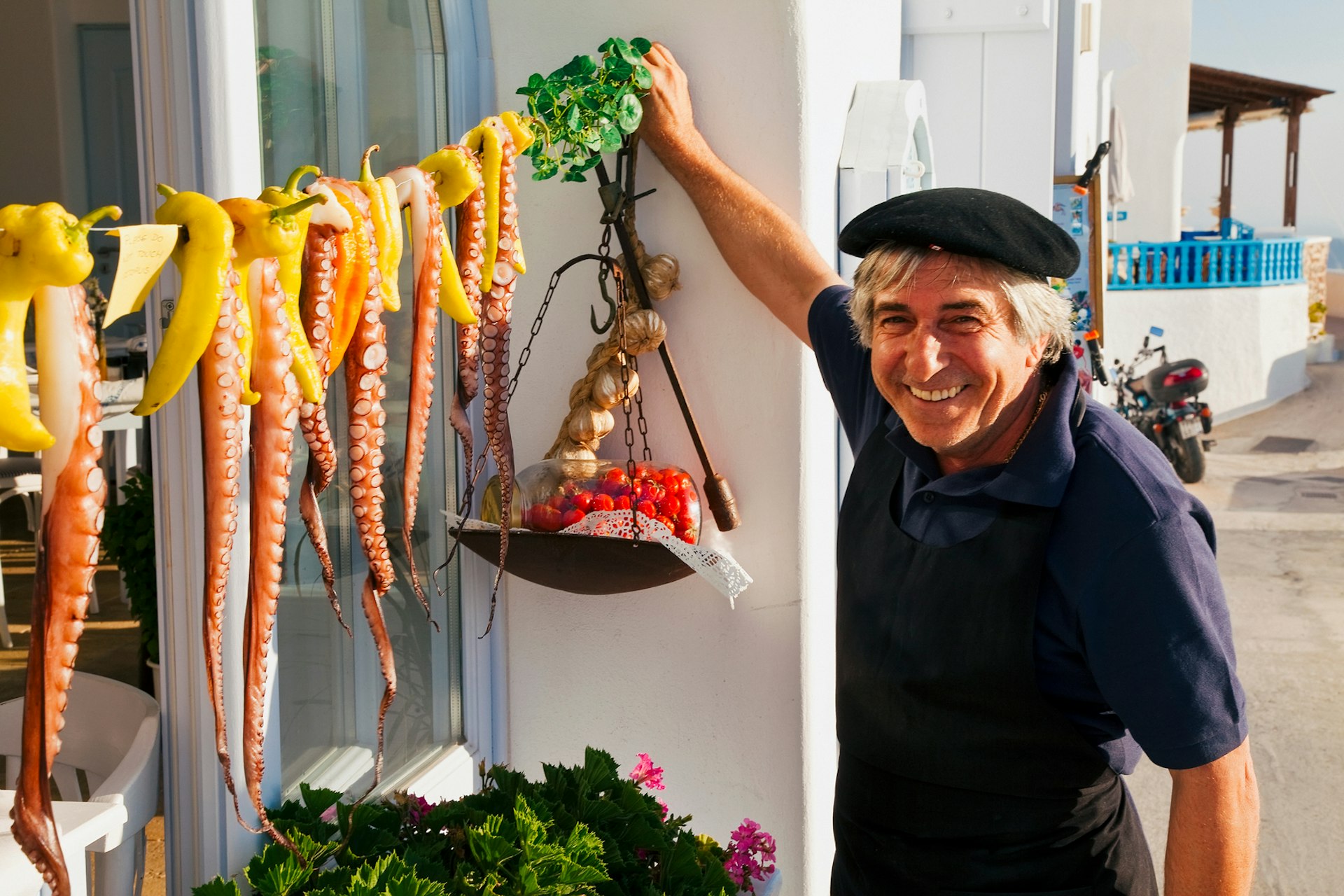
Torn on where to vacation in the Mediterranean?
We’re here to help you out by narrowing down your options to two of the Med’s most popular draws: Greece and Croatia. But which is right for you? We’ll let two passionate and expert travel writers help you decide.
Greece is the word
Based in upbeat Athens since 1996, our Greece expert Helen Iatrou has co-authored Lonely Planet’s Greece and Experience Greece guides. If given the choice, she’ll always choose a sailing yacht to go island-hopping.
Six weeks of gallivanting across Greece’s mountainous mainland and glorious islands three decades ago was all it took to convince me that I needed to relocate there and connect with my ancestral roots.
 Sample fish and seafood meze in Santorini © Gavin Hellier/Stocksy United
Sample fish and seafood meze in Santorini © Gavin Hellier/Stocksy United
When I took the leap, everyone – from taxi drivers to island hotel owners – would say to me, with a big, warm smile: “So, you’ve returned home.” Major points for hospitality, Greece. Philoxenia, which roughly translates to “friend to a stranger,” is an ancient Greek concept that’s all but ingrained in our DNA.
I discovered dozens of Greek-somethings were already here, savoring a slower-paced, less stressful lifestyle. Greek time is actually a thing. If you’ve arranged a coffee date with your Greek friend, don’t stress about running late; they probably are, too. I consider this a healthy relationship with time – and one of many reasons Greece wins in any debate involving its Mediterranean cousin Croatia.
 Odeon of Herodes Atticus, theater below the Acropolis in Athens © Getty Images
Odeon of Herodes Atticus, theater below the Acropolis in Athens © Getty Images
A country with countless options
Your only dilemma is the same one I’ve faced for over 25 years. How do you choose where to go in Greece and when? If it’s your first time here, find your bearings in the country’s capital, considered the birthplace of Western civilization. Among Athens’ priceless global gifts are philosophy, literature and democracy. Reach Classical-era highs at the Acropolis, marveling at the Parthenon, Temple of Athena Nike and the Erechtheion.
Check out the Acropolis Museum, where five of six finely-detailed caryatid sculptures stand proud (the sixth is in the British Museum, along with the Parthenon Marbles; Greece continues its battle to have the marbles reunified with those on display in Athens). Other must-visits are the National Archaeological Museum and the Tactual Museum, originally created for the visually impaired to be able to touch life-size copies of masterpieces like the Venus de Milo.
Archaeological sites and monuments look right at home amid the hubbub of the modern-day captial. The city has evolved into an art destination, with the National Museum of Contemporary Art, the Basil & Elise Goulandris Foundation and even a branch of Gagosian.
 A Greek restaurant in the Plaka neighborhood of Athens © Shutterstock
A Greek restaurant in the Plaka neighborhood of Athens © Shutterstock
Athens neighborhoods bristle with life. Pangrati and Kypseli’s open-air cafes draw espresso connoisseurs. Rebellious Exarchia’s quirky bookshops reel in bibliophiles, while rebetika (Greek blues) joints attract sentimental souls.
Beyond cultural kudos, Athens is one of few European capitals that has Blue Flag beaches. Nope, Zagreb, I don’t mean lakes: fish tavernas, elegant restaurants, hip cafes and beach bars line the 61km (38mi)-long Athens Riviera. At Lake Vouliagmeni, you can even bathe in thermal springs.
Island life
OK, I’ll admit that Croatia has become one of the cool kids of late. Still, its islands don’t stand a chance against Greece’s 227-strong archipelago – a count that only includes the inhabited ones. Opportunities for island-hopping in Greece are simply endless.
 Apella beach on Karpathos island © Pawel Kazmierczak/Shutterstock
Apella beach on Karpathos island © Pawel Kazmierczak/Shutterstock
In the Ionian, fir-clad slopes rise high above emerald seas. In the hills behind Corfu’s Barbati beach, English naturalist and writer Gerald Durrell roamed free as a youngster. Scale the capital’s Old Fortress for views of tightly huddled ocher-, peach- and fuschia-colored neoclassical mansions.
In the Cyclades, millionaire magnet Mykonos and honeymooner favorite Santorini draw most of the attention; consider heading to Naxos to swim at golden sand beaches and relish farm-to-fork fare. Dodge summer crowds in the lesser-trodden Northeastern Aegean. Go windsurfing in Limnos, then chow down on braised cockerel with flomaria (pasta).
 Twilight in Meteora Thessaly © George Papapostolou/500px
Twilight in Meteora Thessaly © George Papapostolou/500px
Back on the mainland, a road trip through Central Greece reveals the country’s vast diversity: from Delphi, the center of the ancient world, to Meteora’s soaring monoliths and Byzantine monasteries.
Schedule a stop in Volos to sample fish and seafood meze with potent spirit tsipouro at one of the port town’s tsipouradika. East of Volos lies densely-forested Pelion, where you’ll find traditional villages, hiking trails and – yes – more beaches.
Honestly: Croatia, I’d quit while you’re ahead.
A Croatian crescendo
Lucie Grace fell in love with Croatia when she unexpectedly moved to its capital city two years ago. Since then, she has traveled the length and breadth of the country, usually on a quest to find the best slice of burek wherever she lands.
Okay, Greece, we all know you’re the birthplace of Western civilization. But isn’t the thrill of travel exploring somewhere that’s new and surprising? Since I moved to Hrvatska (Croatian for Croatia), life has been one marvel after another. I am constantly wowed by the wild, natural sights and diversity of culture in this socially minded gem, where Slavic east meets Roman west, with hints of Ottoman in the mix for good measure. Croatia is a place that will always keep you guessing.
 Imposing city walls of Dubrovnik © Patricia Jekki
Imposing city walls of Dubrovnik © Patricia Jekki
Adriatic aspirations
Take Split, for example: a city founded within a 3rd-century palace. How the walls are still standing after 1700 years blows my mind – and that’s before I take in the warren of cafes, shops, museums and churches that have all made themselves at home within its shiny marble confines. Perhaps the only ancient city in Croatia that’s more beautiful than Split is the “Pearl of the Adriatic,” Dubrovnik – and, let’s be honest, this nickname is absolutely bang-on. Game of Thrones fan or not, you’ll be hard-pressed to be unimpressed by the stately architecture and imposing city walls here.
 Waterfalls of Plitvice National Park in Croatia ©Richard Guijt /Shutterstock
Waterfalls of Plitvice National Park in Croatia ©Richard Guijt /Shutterstock
You’ll then discover that Croatia is packed with amazing natural sights: eight designated national parks make up 10% of the country’s land mass, including the dazzling Plitvice Lakes. The park is a nature-lover’s idyll, with 150 species of birds, 300 types of butterflies and 1200 varieties of plants, all of which congregate around the 16 huge turquoise lakes that flow into each other, connected by cascading waterfalls of fascinating shapes and sizes.
There’s a lot of incredible food in Croatia, too – like the braised meats, stews and dumplings that top the menu inland, or the grilled-fish dishes, shellfish and calamari flowing by the coast. But it’s the pastry snack burek that has captured my heart. You can order cheese, spinach or meat fillings – and they’re a meal in itself. Don’t blame me if you, too, get addicted.
 Cliff jumping in Premantura, Croatia © Andrea Cimini / Shutterstock
Cliff jumping in Premantura, Croatia © Andrea Cimini / Shutterstock
Blue Flag beaches? We got ’em en masse, even in our busy university cities like Rijeka, where the music scene pops off seven days a week. But as a country with a 5835km (3625-mile) coastline, you’re never far from a jaw-dropping aquamarine cove to dive into. And from the hidden coves of Sveti Ivan in Lubenice on Cres to the picturesque Zlatni Rat, a stunning peninsula beach (and drone-flier’s dream) on Brač, there’s an island beach for every occasion.
Now, I’m sorry, Greece, but I think it’s fair to say you have too many islands. With 227, how is anyone supposed to know where to start? Croatia’s 48 inhabited islands are neatly stacked in an elegant row, parallel with the country’s shore, all easy to navigate and reach when compared to the Cyclades or the Dodecanese.
 Old Town of Dubrownik © Getty Images
Old Town of Dubrownik © Getty Images
Magic moments
I’ve said this before and I must stress this again: Croatia is incredibly safe, which is huge for me as a solo female traveler. Name me another country in Europe where you can leave your door unlocked when you pop out and you know everything will be fine? Such safety makes for sublime relaxation. The Dalmatians have a special name for this particular state of bliss: fjaka: the art of chilling out in the hot summer months. It’s so laid-back, it’s meditative.
Finally, my favorite ingredient: the magic in the air. Whether you believe in the ley lines (aka “dragon lines”) of Istria or not, you can’t deny the folklore; it’s everywhere, in every town and city. Friendly giants who built villages, helpful witches who created lakes…there’s something utterly magnetic about Croatia’s ethereal ambience.
And it will keep you longing to come back, year after year.



